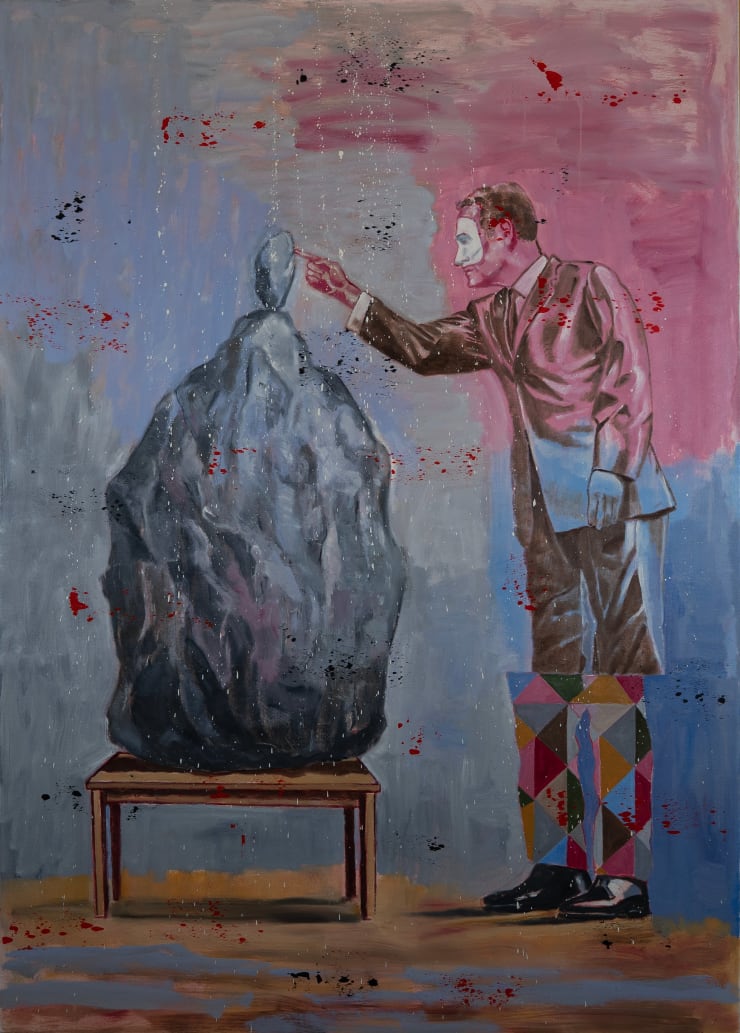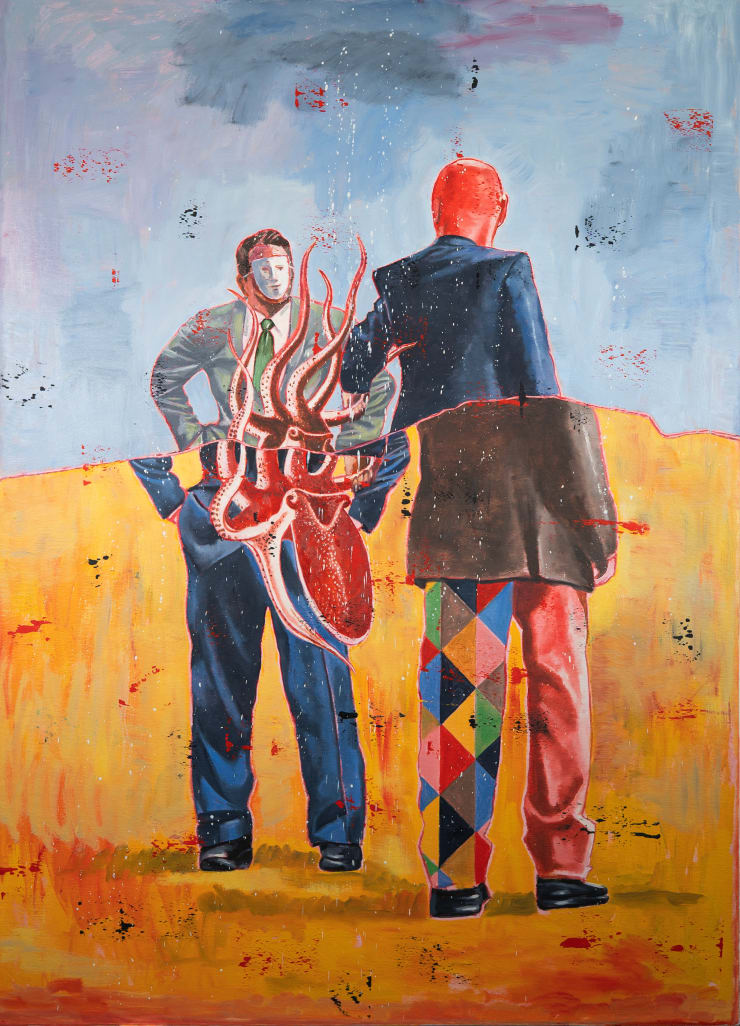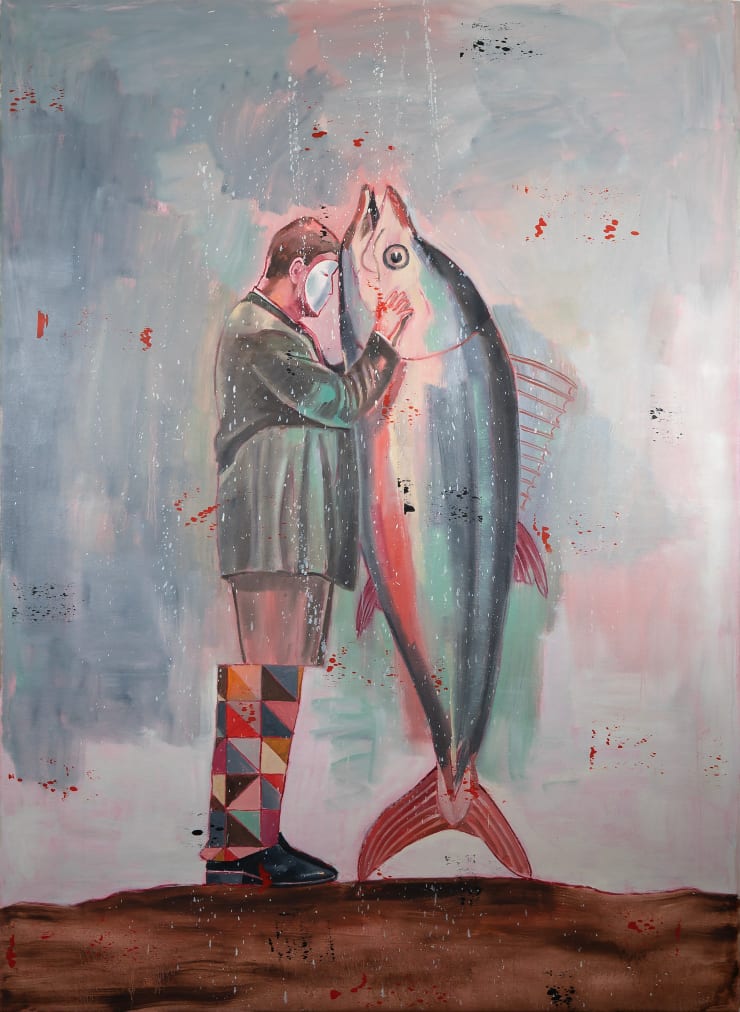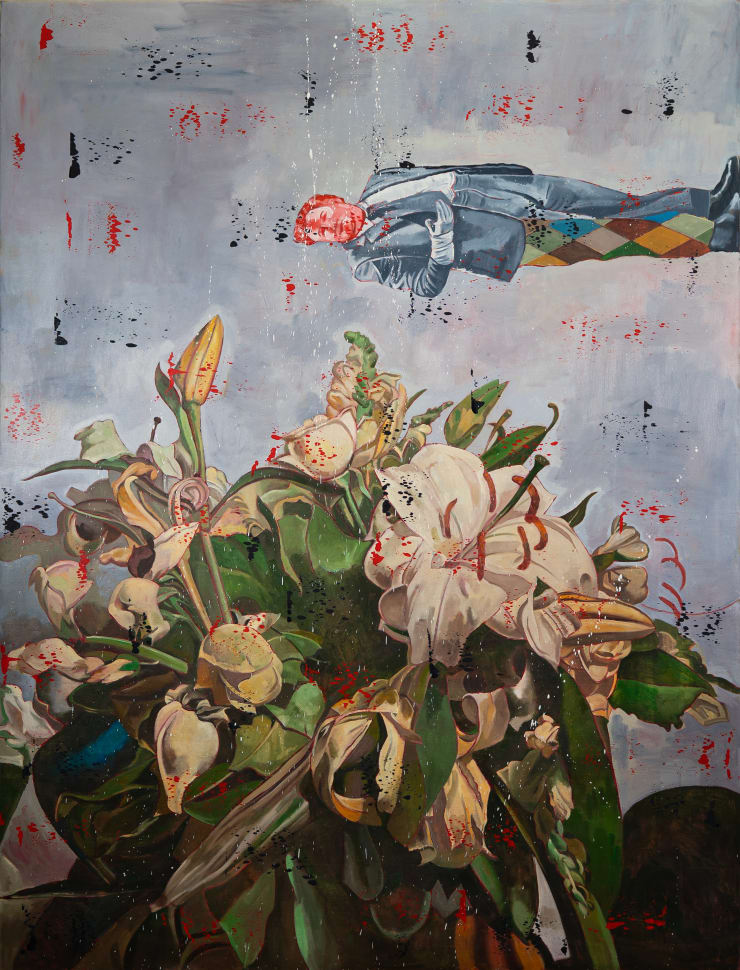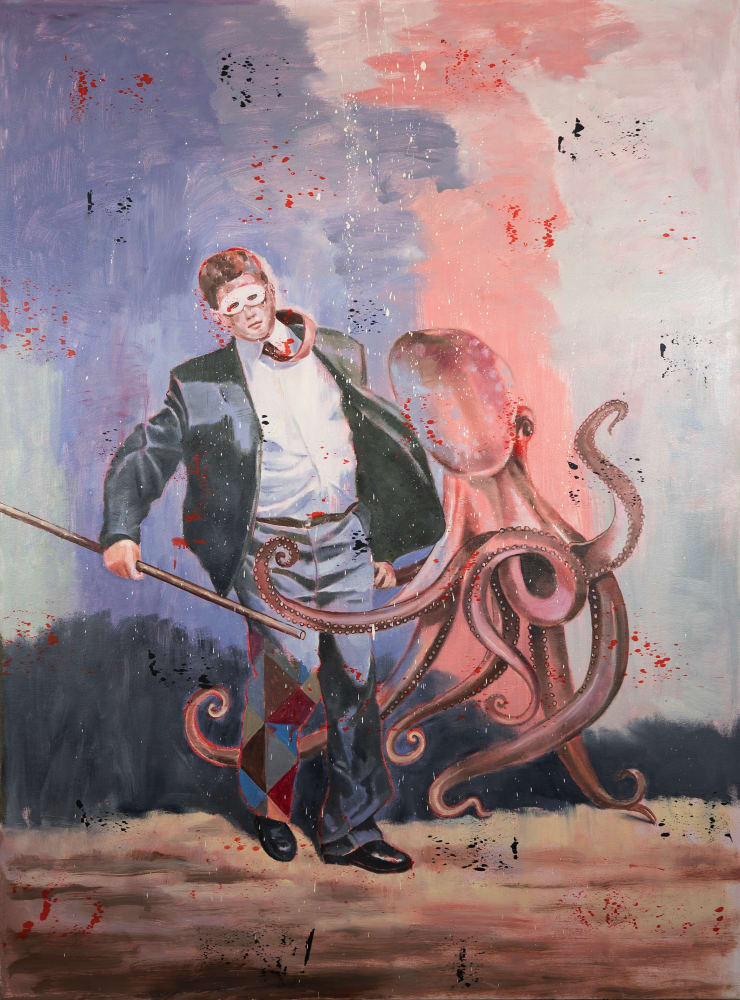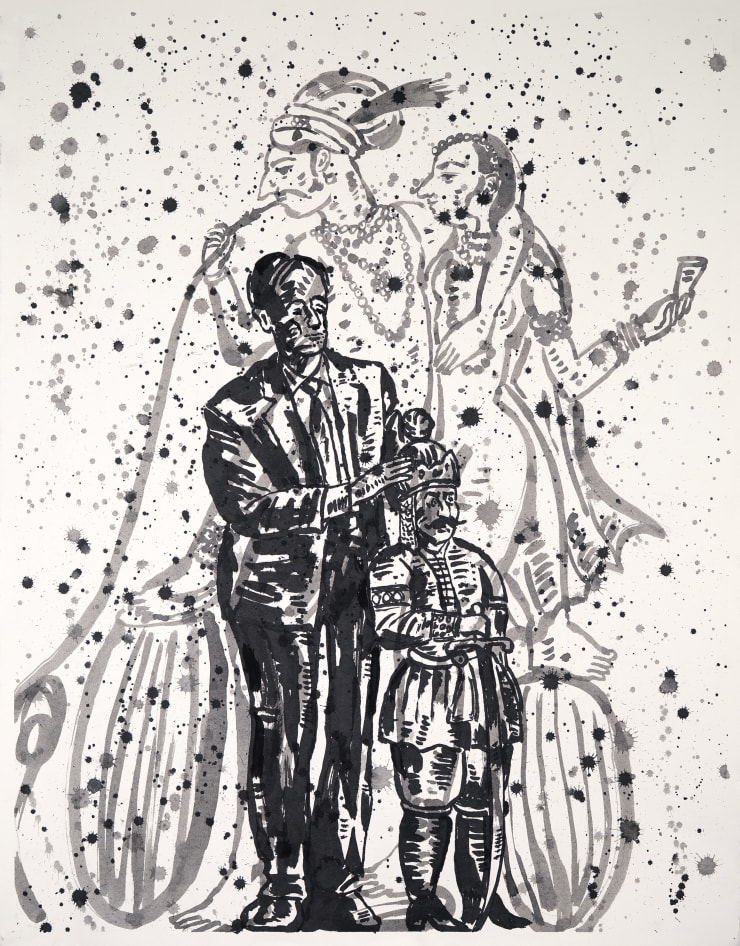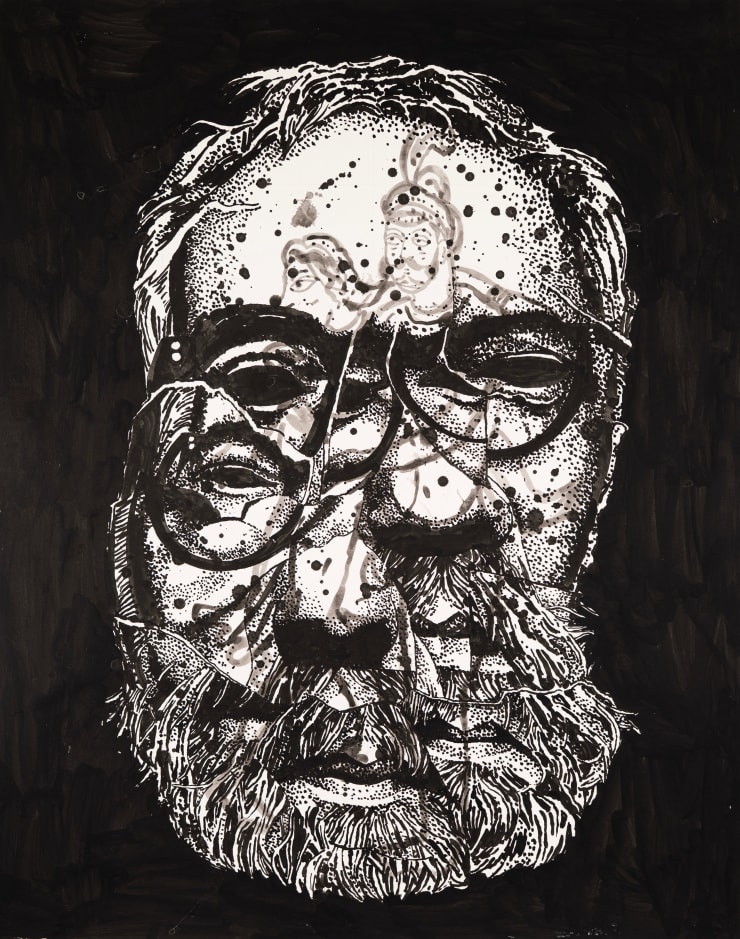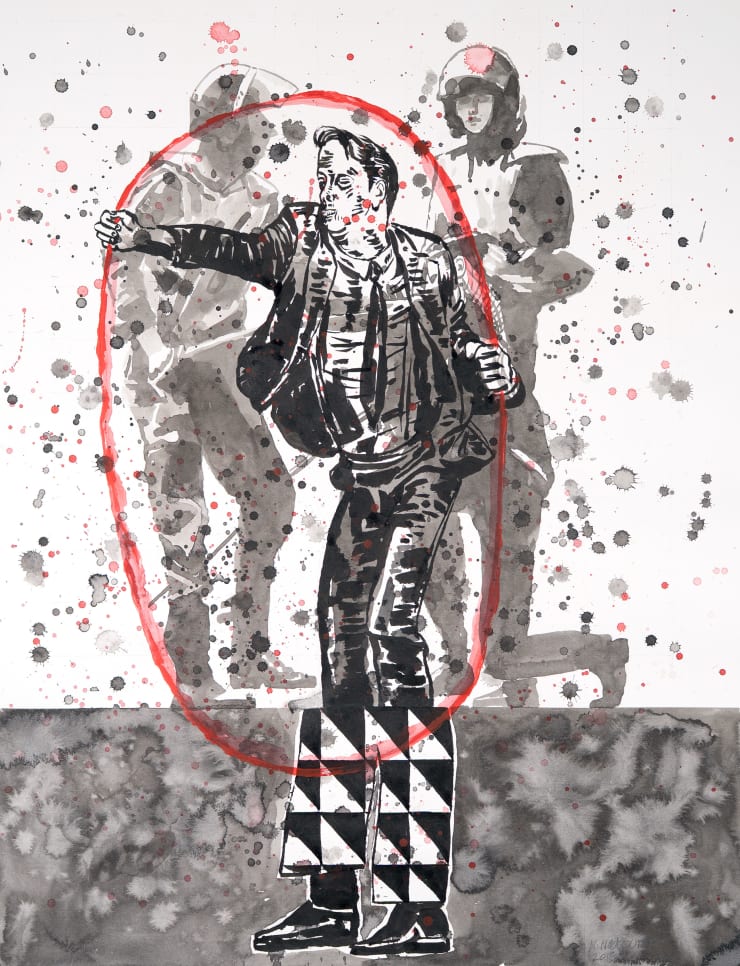-
Taymour Grahne Projects is pleased to present 'Red Line' - an online solo exhibition by NYC-based artist Nicky Nodjoumi (b. 1942, Kermanshah, Iran), opening virtually on May 22, 2025. The exhibition is accompanied by a text written by Shiva Balaghi, Ph.D
-
-
Nicky Nodjoumi: The Power of Art and the Art of Power
Text by Shiva Balaghi, Ph.D.
Among a stack of ink drawings in his studio, there is a recent self-portrait by the artist Nicky Nodjoumi. His black rimmed spectacles, full beard and tussled grey hair are clearly recognizable. But the image seems to be torn asunder, the artist’s face appears chimeric, disjointed. Layered across the face like a tattoo is a scene rendered in faint hues in the style of historic Persian manuscripts depicts a warrior and a woman. Drops of ink cover the image, the eyes rendered in a piercing dark black. The effect is hallucinatory, discombobulating. As though the past, a wounded past, hangs over the artist.
The drawing recalls a series of black and white photographs Nodjoumi took in the early 1980s. In one self-portrait, he holds his hands across his face, only one eye peering through his fingers. His gaze is directed at an unknown audience or perhaps only at himself. Layers of shadow and light flow across the image. It is a quietly disturbing photograph. Part of Nodjoumi’s personal archives, it’s one of numerous photographs he took upon returning to the United States following the 1979 Iranian Revolution. The disruption of revolutionary betrayal and the upheaval of exile had created fissures in Nodjoumi’s artistic flow and his sense of belonging. The camera became his constant companion, helping him to convey his inner turmoil into a visual language. The two pictures are autobiographical, telling a story about the artist at a particular time and place. They trace his decades long journey of creative exploration between form and content, between art and politics.
Nodjoumi had originally come to the US in 1970 to study art and to seek medical care for a heart condition. Searching for a trusted physician among the Iranian ex-pat community, he made connections with student groups organizing for greater political freedoms in Iran and those protesting the Vietnam War. As Nodjoumi’s engagement with social movements grew, he set up a makeshift poster workshop, sometimes displaying his work in the lobby of the New School. He made a short animation film criticizing the Vietnam War and designed posters for the Black Panthers, for Palestinian liberation, and against human rights abuses in Iran. By 1975, he was traveling back to Tehran, exhibiting his art in local galleries. Soon, his activism and his art came to the notice of the Shah’s secret police, the SAVAK. Nodjoumi was arrested, interrogated, and pressured to sign a document disavowing his political affiliations and activities. Though released, he was prohibited from teaching art and uncertain of his ability to exhibit work, so he returned to the U.S. -
With the outbreak of mass protests in Iran in 1978, Nodjoumi once again returned to Tehran. He helped establish a poster workshop at the University of Tehran, which provided materials and training for various political groups. Amateur artists worked alongside some of Iran’s leading artists, displaying their posters in schools, in factories, and on the walls of buildings.
As protests intensified, Nodjoumi walked the streets of Tehran. He sketched furiously, pouring what he saw, heard, and felt into impressionistic images, which became the basis for a series of murals he painted titled, Reports of the Revolution.As the Shah’s government fell, the Islamic revolutionary elements began to cease control of Iran’s state apparatus, including the Tehran Museum of Contemporary Art (TMOCA). Opened in 1977, TMOCA was envisioned as a showcase of modernity. It housed an extensive collection of European, American, and Iranian modern art, carefully collected under the auspices of the Queen, Farah Diba. In October 1979, the nascent revolutionary government reopened TMOCA, with a banner hung over its entrance announcing, “This belongs to the people, and we represent the culture of the people.”
Among the early exhibitions organized at TMOCA following the revolution was a Nodjoumi retrospective, featuring 130 artworks including his revolutionary murals.Soon after the exhibit opened, however, a damning review was published in an official newspaper, condemning Nodjoumi as a once revolutionary artist corrupted by his years of living in the U.S. His murals, the review claimed, depicted a chaotic and frightening view of the revolution. The day after the review was published, a group of angry revolutionary youth tried to storm the museum; some paintings were removed from view. Aware of the dangers inherent in such a hostile public response to his art, Nodjoumi slipped out of the country into a life of exile in September 1980. After only three weeks, his exhibition at TMOCA was hastily dismantled—the fate of the artworks representing two decades of his artistic career remained in question.
Nodjoumi’s return to the U.S. in the 1980s was an unsettling experience. “Mine was a forced migration,” he recalls. There was a sense of estrangement, from his countryand from art. The coming years would become a search for space, on his canvas and in the art world, in which he could reconcile his politics into an aesthetic form that would hold meaning for himself while resonating with a Western audience. He found his way through sketching. As he reads the morning papers, he translates the news of the day into sketches sometimes even drawing directly on the newspaper. The figures that emerge from these newspaper drawings echo the style of his political posters from the 1970s. As they evolve and take shape, they migrate onto his canvases.
Sketching contains the urgency of the political moment. In his larger paintings, Nodjoumi translates his point of view into layered visual compositions, using juxtaposition, allegory, and irony. Holland Cotter, the Pulitzer Prize winning art critic, has been following Nodjoumi’s art since seeing some of his political posters in an exhibition at NYU’s Grey Museum of Art in 2002. Nodjoumi’s paintings, Cotter observed in The New York Times, are “wry, poetic, and opaque.”1At any given time, Nodjoumi is working on several paintings, the large canvasses nailed to a long wall on his Brooklyn studio. Against arid but colorful backgrounds devoid of representation, he depicts characters inspired by political figures of the day.
-
“Large canvases with full-size, eye-level figures create confrontation or rather a confrontational dialogue between the painting and the viewer,” he explains. “I like the empty nothingness of the background because it conveys a nonspecific reality to the point that reality becomes an abstraction. Although, at times, I use recognizable political figures that put the viewer in a specific time and place, the void in the background helps to focus the viewers’ attention to the dialogue amongst the figures rather than the time and place."
On the canvas, Nodjoumi pushes the boundaries of painting, finding new ways to convey meaning through his art. Composition, imagery, color, and decorative elements all play into the structures of feeling embedded in his paintings. His visual narratives are about seeing certain truths rather than providing the viewer clarity and concrete understandings. Eschewing facile narratives, his paintings depict the uncertainties, instability, and confusion inherent in the human condition. Power and politics undergird his creative expression. “The paintings are generally about people in power, it doesn’t matter what country. They are demagogues, they are hypocrites,” Nodjoumi explains. His art underlines the absurdity of power politics, the ways it seeps into the quotidian.
Over decades, Nodjoumi has formed a close friendship with the artist Shirin Neshat. In the early 2000’s, she visited an exhibition of Nodjoumi’s in a New York gallery. Moved by the paintings, she purchased a large canvas, the first work of art she ever acquired. Shortly thereafter, she wrote an essay about Nodjoumi’s art for an Italian publication. “At first look, Mr. Nodjoumi’s [paintings are] politically charged critiques of ‘power’, whether religious or governmental, Muslim or American,” Neshat wrote. “These obscure narratives intelligently and humorously confront the viewer with the absurdity and hypocrisy behind those characters who control our lives…One sees through the artist’s subconscious, facing his own existential anxieties in life, that of the experience of exile, repression, taboos, alienation and mortality.”2
Making art is how Nodjoumi understands his own place in the world. His paintings reveal his concerns with constructed borders—and who gets to live within those borders and who is kept out. He has concerns about the environment, about wars, about revolutions and social inequities. And his concerns are not just abstract political views, they are also rooted in his personal experiences, his bifurcated life between Iran and the U.S. They convey a darkness that remains embedded within him, but also a joy that permeates his being. His joy in dancing with his grandchildren as they play music. His joy in engaging with an extended community of artists in New York and Tehran. His joy in living a true life as a committed artist, despite the challenges he has faced.
In 2023, his daughter Sara Nodjoumi and son-in-law Till Schauder directed an award-winning documentary about his life as an artist. A Revolution on Canvas was screened around the world to rave reviews. The film ends with a sweeping view of a red brick building, with the New York City landscape hovering above. Nodjoumi is seen through the arched windows of his Brooklyn studio, walking up to a series of canvasses on that long wall, dipping his brush into paint, and making art. Over a career that has spanned six decades, despite the upheavals and disruptions he has faced, one thing has remained a constant. Every day, he can be found in his studio, making art about the world as it is and as it could be. The worlds Nodjoumi depicts in his paintings are a brilliant kaleidoscope, revealing the power of art and the art of power.
--
1 Holland Cotter, “Art in Review: Nicky Nodjoumi,” NYT, January 31, 2003.
2 Shirin Neshat, “Nicky Nodjoumi,” Atlantica, no. 35 (2003).
-
-
Nicky Nodjoumi's works have been acquired by prominent institutional collections worldwide, including: the Metropolitan Museum of Art in New York, the British Museum in London, LACMA in Los Angeles, the Guggenheim in Abu Dhabi, and the Nelson-Atkins Museum in Kansas City, among others. In 2014, Nicky had a solo exhibition at the Cleveland Institute of Art titled The Accident, and in 2019 a solo exhibition at the Kansas City Art Institute, titled The Long Day. The artist lives and works in Brooklyn. His shows have been reviewed by major publications, including The New York Times, The New Yorker, The Brooklyn Rail, and the Boston Review, among others.
-
Nicky Nodjoumi's CV here
Nicky Nodjoumi: Red Line
Past viewing_room

